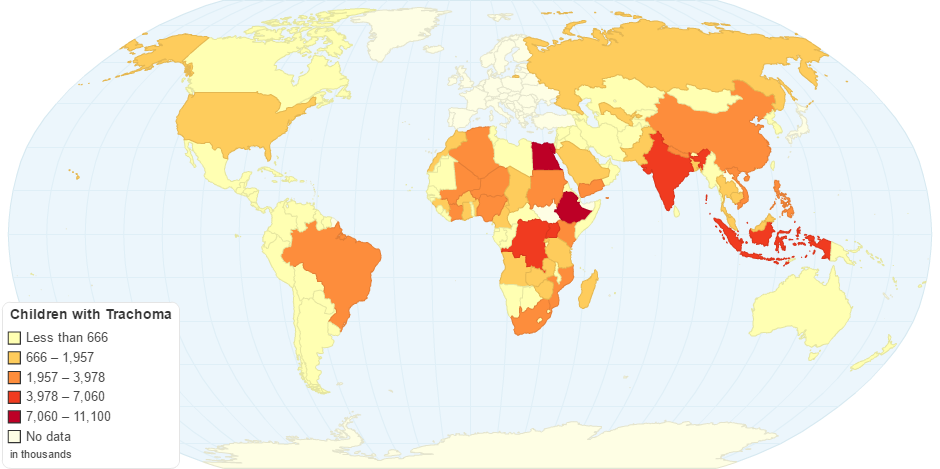This chart shows Children with Trachoma by Country.
Trachoma, also called granular conjunctivitis, Egyptian ophthalmia,and blinding trachoma, is an infectious disease caused by bacterium Chlamydia trachomatis. The infection causes a roughening of the inner surface of the eyelids. This roughening can lead to pain in the eyes, breakdown of the outer surface or cornea of the eyes, and eventual blindness.
The bacteria that cause the disease can be spread by both direct and indirect contact with an affected person's eyes or nose. Indirect contact includes through clothing or flies that have come into contact with an affected person's eyes or nose. Children spread the disease more often than adults. Poor sanitation, crowded living conditions, and not enough clean water and toilets also increase spread.
Globally, about 80 million people have an active infection.In some areas infections may be present in as many as 60–90% of children and it more commonly affects women than men likely due to their closer contact with children.The disease is the cause of decreased vision in 2.2 million people of whom 1.2 million are completely blind.It commonly occurs in 53 countries of Africa, Asia, Central and South America with about 230 million people at risk.
The bacterium has an incubation period of 5 to 12 days, after which the affected individual experiences symptoms of conjunctivitis, or irritation similar to "pink eye." Blinding endemic trachoma results from multiple episodes of reinfection that maintains the intense inflammation in the conjunctiva. Without reinfection, the inflammation will gradually subside.
The conjunctival inflammation is called “active trachoma” and usually is seen in children, especially pre-school children. It is characterized by white lumps in the undersurface of the upper eyelid and by non-specific inflammation and thickening often associated with papillae. Follicles may also appear at the junction of the cornea and the sclera.
Facial cleanliness: Children with grossly visible nasal discharge, ocular discharge, or flies on their faces are at least twice as likely to have active trachoma as children with clean faces.Intensive community-based health education programs to promote face-washing can significantly reduce the prevalence of active trachoma, especially intense trachoma.
9 years ago

